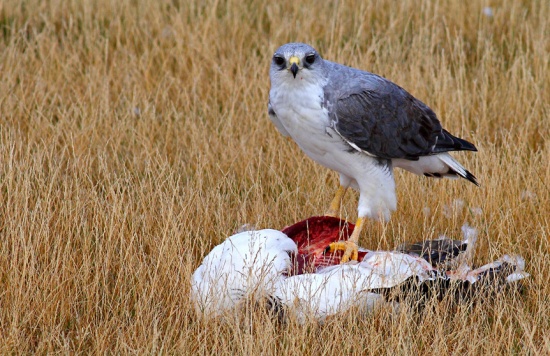
Photo © by w32aphex
Falkland Islands, April 2010
Alternative name: Red-backed Hawk
- Geranoaetus polyosoma
Includes Puna Hawk
Identification
Length 45-62 cm (17¾-24½ in), wingspan 110-150 cm, weight c. 950-1000 g
- White tail with black sub-terminal band but otherwise very variable in plumage
- Lacks black commas or larger black marks seen on wing underside at the wrist of most similar species
- Legs yellow; bill with yellow base and blackish tip
Male
- Grey back (mantle can be reddish on some individuals; see also Subspecies, below); light grey in light morph, dark grey in dark morph
- White underparts in light morph, dark grey underparts in dark morph
Female
- Usually has a rufous mantle; may have either white underparts (light morph) or rufous or rufous-and-black underparts (dark morph).
Juvenile
- Mottled brown
The wings fall short of the tip of the tail on the sitting bird in the "Red-backed" form while the "Puna" form (formerly a separate species) has wingtips that reach the tip of the tail; this seems to be the best separator of the two subspecies.
Distribution
South America: found in Colombia, Ecuador, Peru, Bolivia, Chile, Argentina, and Falkland Islands; vagrant to Uruguay, Brazil.
Taxonomy
Formerly placed in genus Buteo
Subspecies
Two[1] to four subspecies are accepted by different authorities[2]:
- G. p. polyosoma - Andes of western Colombia south to Tierra del Fuego, and Falkland Islands (Red-backed Hawk)
- Smaller; 46-56 cm, wingspan 110-120 cm; light morph males mostly grey-backed, white below, females rufous-backed, white below; dark morph males dark grey above and below, females rufous-backed and rufous breasted
- G. p. exsul - Juan Fernadez Islands, Chile (Juan Fernadez Hawk)
- Slightly larger; both sexes grey-backed
- G. p. poecilochrous - High Andes from s Colombia to s Ecuador (Puna Hawk)
- Larger; 51-61 cm, wingspan 125-150 cm
- G. p. fjeldsai - Andes from n Peru to nw Argentina (described 2009, as a split from Puna Hawk)
There is an active debate as to whether Red-backed Hawk, Juan Fernadez Hawk, and Puna Hawk are three species or one. Opus follows a consensus according to which it is one, Variable Hawk.
Habitat
Open areas to open forest, but most likely in areas with scrub and some trees in steep terrain. Observed at heights up to around 3000 meters in the north of its range, lower down further south. Where overlapping with Puna Hawk, the form Red-backed Hawk is normally seen at lower elevation.
Behaviour
Diet
Eats primarily mammals but with a significant amount of insects and some birds. Pairs sometimes hunt co-operatively, taking birds in flight as large as Upland Goose (3 kg, 50% more than the combined weight of the hunting pair).
Breeding
It nests in treetops. The nest is large and made of dry sticks. The clutch generally consists of 2 white eggs with light reddish spots.
References
- Clements, J. F., T. S. Schulenberg, M. J. Iliff, D. Roberson, T. A. Fredericks, B. L. Sullivan, and C. L. Wood. 2017. The eBird/Clements checklist of birds of the world: v2017, with updates to August 2017. Downloaded from http://www.birds.cornell.edu/clementschecklist/download/
- Gill, F and D Donsker (Eds). 2014. IOC World Bird Names (version 4.3). Available at http://www.worldbirdnames.org/.
- Avibase
- BF Member observations
- Restall et al. 2006. Birds of Northern South America. Yale University Press. ISBN 9780300124156
- Birdforum thread mentioning several taxonomic proposals, of which 460 is relevant here
- Birdforum thread with details of feeding ecology
Recommended Citation
- BirdForum Opus contributors. (2025) Variable Hawk. In: BirdForum, the forum for wild birds and birding. Retrieved 27 April 2025 from https://www.birdforum.net/opus/Variable_Hawk







